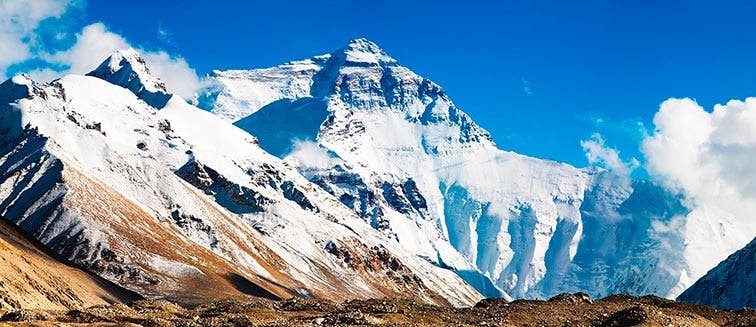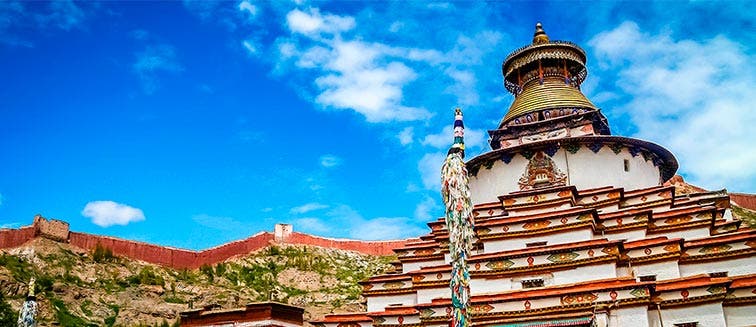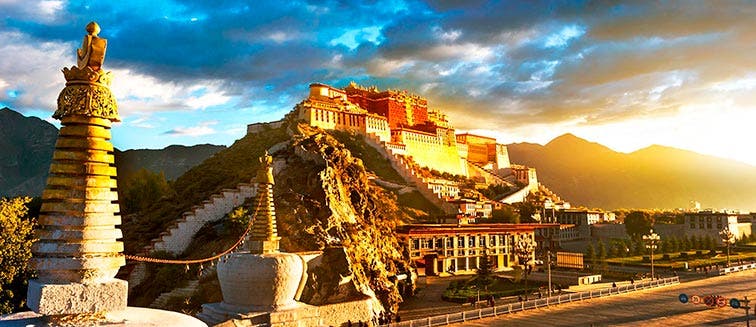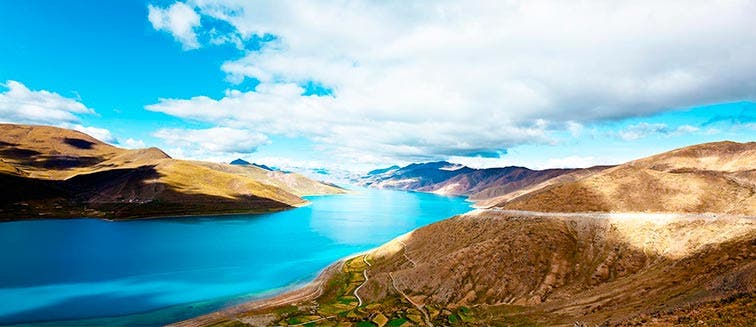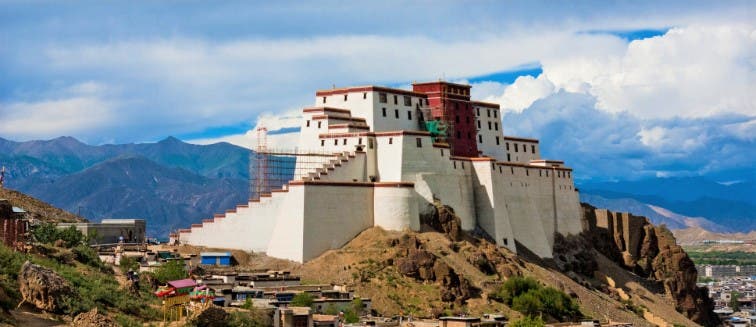Africa
Americas
Asia
Europe
Oceania
Holidays to Europe (97 available)
Albania(2)
Austria(7)
Baltic States(3)
Belgium(5)
Croatia(3)
Cyprus(1)
Czech Republic(5)
Denmark(1)
England(12)
Finland(2)
France(15)
Germany(8)
Greece(12)
Hungary(5)
Iceland(6)
Ireland(9)
Italy(13)
Montenegro(1)
Netherlands(5)
Northern Ireland(2)
Norway(9)
Portugal(9)
Romania(1)
Scotland(6)
Slovakia(1)
Spain(9)
Sweden(2)
Switzerland(4)
By Season
By Interest
By Group
What to see in Tibet
Base camp Everest
- Vacations to Tibet
- Points of Interest
Tourist attractions Base camp Everest
The road known as the Friendship Highway, one of the highest in the world, is a gigantic engineering work that connects Lhasa with Kathmandu through 806 km. Although it is paved, some parts lack asphalt and have potholes, so it is ideal to drive in off-road vehicles. It runs at an average altitude of 4000 metres through the Tibetan plateau until reaching the Himalayas, where it zigzags between the mountains to descend sharply on the opposite side of the mountain range to reach Nepal.This famous scenic route guides the journey that unites the capital of Tibet and the north face of the base camp of Everest, crossing the towns of Shigatse, Lhatse, Shegar and Tingri.At 157 km towards the southwest of Shigatse, Lhatse is located and between both, is the mountain pass Tropu La at 4950 metres above sea-level. The landscape is enlivened by cattle pastures, rapeseed plantations, rivers, barley fields, high mountains and villages. Lhatse is a small town in the valley of the Yarlung Tsangpo River, located at 4050 metres altitude and is composed of a single unpaved road and a small square near the centre.From here, the Friendship Highway deviates to the left towards Kathmandu until reaching its highest point, the Gyatso-La mountain pass at 5248 metres, where there is a huge landmark adorned with hundreds of prayer flags with an inscription indicating the entrance to the Everest Natural Park, which houses the base camps of Cho Oyu and Everest and the Rongphu Monastery. From here you can admire the overwhelming view of the highest peak in the world, Everest or Chomolungma in Tibetan, along with another four mountains, Makalu, Lhotse, Gyachen Kang and Cho Oyu. Following the path and descending towards an infinite valley crossed by a stream, one arrives at Shegar, having travelled 150 km from Lhatse.The town of Shegar, also called New Tingri, is 4300 metres above sea level and dominated by the ruins of the "Crystal Dzong", whose defensive walls meander the steep slopes of a mountain that rises at the foot of the city. In the 12th century monastery built below, there are still monks who sing mantras and play horns and drums during their Buddhist rituals.The route continues 60 km further to the town of Tingri, generally known as Old Tingri, home to some 500 inhabitants. It gives its name to a vast and extensive plain bordered by an arid mountain range to the north and by the imposing peaks of the Himalayas to the south, with Everest at the head. From this plain you can rest your eyes on the horizon and clearly observe a wild landscape, with villages and roaming cattle, which contrasts with the blue sky of the most vibrant shade you can imagine. The light in Tibet is unique and the colours are appreciated as being more pure and radiant.It had great importance in the past as a trading post for the exchange of products between the Nepali and Tibetan Sherpas and it was the mythical place of departures of the old expeditions of the 1920s, although nowadays it is simply a night stop for hikers and climbers. The restaurants, hotels and repair workshops for trucks and motorcycles are concentrated on one unique street, the well-known highway 318.At 5100 metres altitude and 200 metres from the base camp is the Rongbuk Buddhist Monastery, the most important in the valley, the highest inhabited religious center in the world and an important pilgrimage center. It was founded in 1902 by Lama Rongbuk, who helped the first climbers when they arrived in the area and who used the monastery as a stop on their travels. The Chorten, a circular white pagoda in front of the monastery, contains a reliquary inside and a pile of stones, flat rocks and small pebbles that are piled up as an offering to the spirits and carved with a mantra prayer and words of devotion. The image that is achieved in this same point, with the snowy peaks of the Himalayas as a backdrop, is one of the most iconic and spectacular in the world.South of the Rongbuk Monastery, a large stone marks the "Base Camp of Mount Qomolangma" written in Tibetan, Chinese and English. It indicates the 5200 metres of altitude and is is 8 km away from the base of the Everest at a staggering 8848 metres above sea-level.To travel to such a remote part of the world is a real achievement and not just for the physical effort necessary to adapt to the altitude, but also for the satisfaction of a dream fulfilled, because the one who arrives here does not do so by chance. The sensation of fullness and serenity when observing oneself as a mere spectator before such giants of nature, triggers a unique emotion that invites one to listen to silence and to meditate on the essence of being as if time stopped.
Lovers of astro-tourism can find in these clear skies a unique place in the world to enjoy the party of stars and contemplate how they dance in the unique darkness around the "Mother of the Universe", as Mount Everest is called. It is an overwhelming spectacle that will leave you speechless.
This beautiful journey is full of meaning. It is a trip that crosses rivers, monasteries, mountains, museums, desert and snowy terrains, glaciers and lakes. Everest is loved by villagers, nomadic shepherds, monks, sportsmen and travellers and enlivened by the soundtrack of the wind, the mantras and the tinkling of the bells of the yaks. Travelling to Everest Base Camp is a magical experience that is never forgotten. An unparalleled place that gives to those who visit a confrontation with the most important mountain range on Earth.
We don't have any trips to Base camp Everest at the moment.
Subscribe to our newsletter to not miss any trips
YOU ALSO LIKE
China
4 Trips
Hong Kong
1 Trips
Japan
10 Trips
Mongolia
Notify me when available
South Korea
6 Trips
Taiwan
Notify me when available
Tibet
Notify me when available
Turkey
9 Trips
Jordan
6 Trips
Israel
Notify me when available
Armenia
Notify me when available
Uzbekistan
2 Trips
Oman
Notify me when available
Lebanon
Notify me when available
Kazakhstan
1 Trips
Kyrgyzstan
Notify me when available
Qatar
4 Trips
Bahrain
1 Trips
Cambodia
4 Trips
Thailand
6 Trips
Vietnam
6 Trips
Myanmar
Notify me when available
Indonesia
8 Trips
Malaysia
2 Trips
Philippines
2 Trips
Singapore
2 Trips
Laos
Notify me when available
India
10 Trips
Bhutan
2 Trips
Nepal
5 Trips
Sri Lanka
5 Trips
Maldives
6 Trips
United Arab Emirates
4 Trips
Saudi Arabia
2 Trips
Tourist attractions tibet
Points of interests
Other Points of interests
- Trips to Andong
- Trips to Beijing
- Trips to Busan
- Trips to Chengdu
- Trips to Chongqing
- Trips to Dunhuang
- Trips to Guilin
- Trips to Gyeongju
- Trips to Hakone
- Trips to Hangzhou
- Trips to Hiroshima
- Trips to Hokkaido
- Trips to Hong Kong
- Trips to Huangshan
- Trips to Jeju Island
- Trips to Jeonju
- Trips to Jiuzhaigou National Park
- Trips to Kanazawa
- Trips to Kumano Kodo
- Trips to Kyoto
- Trips to Lantau Island
- Trips to Lhasa
- Trips to Li River
- Trips to Matsumoto
- Trips to Mount Fuji
- Trips to Mount Koya
- Trips to Nagoya
- Trips to Nara
- Trips to Nikko
- Trips to Okinawa
- Trips to Osaka
- Trips to Repulse Bay
- Trips to Sapporo
- Trips to Seoul
- Trips to Shanghai
- Trips to Shibuya Crossing
- Trips to Shirakawa-go
- Trips to Stanley Market
- Trips to Suzhou
- Trips to Takayama
- Trips to Three Gorges Dam
- Trips to Tokyo
- Trips to Ulaanbaatar
- Trips to Victoria Peak
- Trips to West Lake
- Trips to Wuxi
- Trips to Xi'an
- Trips to Yangshuo
- Trips to Yangtze river
- Trips to Yeosu
- Trips to Zhangjiajie
Countries Nearby
- Armenia Trips
- Bahrain Trips
- Bhutan Trips
- Cambodia Trips
- China Trips
- Hong Kong Trips
- India Trips
- Indonesia Trips
- Israel Trips
- Japan Trips
- Jordan Trips
- Kazakhstan Trips
- Kyrgyzstan Trips
- Laos Trips
- Lebanon Trips
- Malaysia Trips
- Maldives Trips
- Mongolia Trips
- Myanmar Trips
- Nepal Trips
- Oman Trips
- Philippines Trips
- Qatar Trips
- Saudi Arabia Trips
- Singapore Trips
- South Korea Trips
- Sri Lanka Trips
- Taiwan Trips
- Thailand Trips
- Tibet Trips
- Turkey Trips
- United Arab Emirates Trips
- Uzbekistan Trips
- Vietnam Trips
Trip Styles
- Solo Tours in China Trips
- China Cultural Tours Trips
- Family India Trips
- India Solo Travel Offers Trips
- India Nature Vacation Packages Trips
- Solo Trips to Indonesia Trips
- Indonesia Couples Tour Packages Trips
- Indonesia Nature Vacation Packages Trips
- Family Japan Trips
- Japan Solo Travel Packages Trips
- Japan Cultural Tours Trips
- Solo Adventures in Jordan Trips
- Thailand Nature Packages Trips
- Family Thailand Trips
- Thailand Tours for Couples Trips
- Thailand Solo Tours with Exoticca Trips
- Turkey Cultural Tours Trips
- Turkey: A Romantic Haven for Couples Trips
- Vietnam Solo Travel Packages Trips
- Vietnam Nature Vacation Packages Trips
- Vietnam Cultural Tours Trips
Susbscribe to our newsletter and join Exoticca GO
The best travel deals
Exclusive promotions
Expert travel tips
